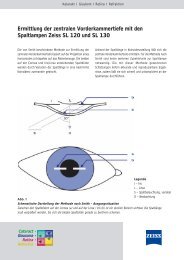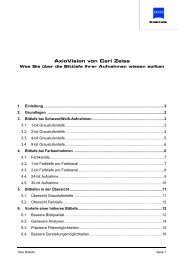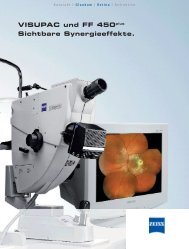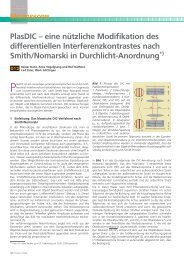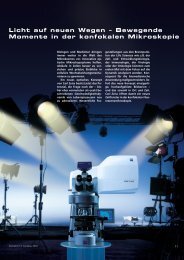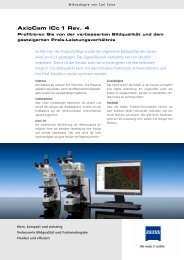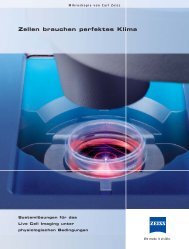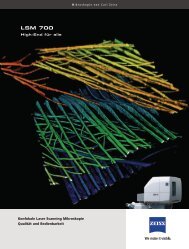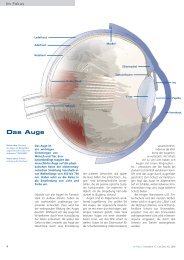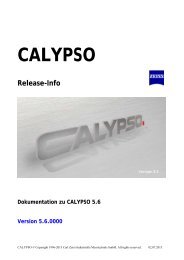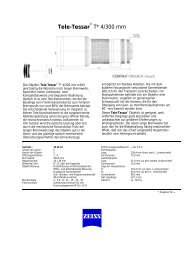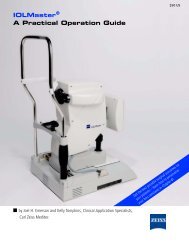Unveiling the Secrets of Thinking - Carl Zeiss
Unveiling the Secrets of Thinking - Carl Zeiss
Unveiling the Secrets of Thinking - Carl Zeiss
Create successful ePaper yourself
Turn your PDF publications into a flip-book with our unique Google optimized e-Paper software.
Cover Story: (Re)solution<br />
years to record <strong>the</strong> brain<br />
<strong>of</strong> a mouse, not to<br />
mention <strong>the</strong> mapping<br />
<strong>of</strong> <strong>the</strong> human thinking<br />
apparatus.<br />
A puzzle with many facets.<br />
Even <strong>the</strong> initial<br />
preparation <strong>of</strong> a brain<br />
section is no easy matter.<br />
The material is subsequently<br />
embedded in syn<strong>the</strong>tic resin<br />
and cut with a microtome,<br />
a type <strong>of</strong> planing device, into<br />
wafer-thin slices that are applied<br />
to a wafer and imaged in a<br />
scanning electron microscope. Such a<br />
specimen has a volume <strong>of</strong> about one<br />
cubic millimeter; this cube is cut up<br />
into about 20,000 slices. Vast processing<br />
times are required to subsequently<br />
merge <strong>the</strong> resulting huge<br />
quantities <strong>of</strong> image data into a<br />
three-dimensional image in <strong>the</strong> computer<br />
again.<br />
Speed means success. <strong>Carl</strong> <strong>Zeiss</strong> is<br />
supporting this research work with<br />
intelligent solutions. With <strong>the</strong> aid <strong>of</strong><br />
<strong>the</strong> SIGMA TM field emission scanning<br />
electron microscope (FE-SEM), biologist<br />
Jeff Lichtman from Harvard University<br />
in Cambridge, Massachusetts,<br />
is examining pieces <strong>of</strong> a mouse’s<br />
brain. The system is equipped with a<br />
special detector system and s<strong>of</strong>tware<br />
that allow 100 times faster image<br />
generation and storage than with<br />
traditional systems. For John Mendenhall<br />
<strong>of</strong> <strong>the</strong> University <strong>of</strong> Texas in<br />
Austin, speed is an important argument<br />
in favor <strong>of</strong> using a ZEISS FE-<br />
SEM. Toge<strong>the</strong>r with a special application<br />
solution, <strong>the</strong> system has an<br />
image memory with a capacity <strong>of</strong> up<br />
to one gigapixel and <strong>the</strong>refore permits<br />
<strong>the</strong> recording <strong>of</strong> large-area<br />
specimens at maximum resolution.<br />
Dr. Marco Cantoni <strong>of</strong> <strong>the</strong> Ecole Polytechnique<br />
Fédérale de Lausanne in<br />
Switzerland examines mouse brains<br />
with a CrossBeam ® microscope. Instead<br />
<strong>of</strong> a mechanical technique, an<br />
ion beam is used to remove <strong>the</strong> specimen<br />
slice by slice, with <strong>the</strong> result<br />
<strong>the</strong>n being examined in <strong>the</strong> scanning<br />
electron microscope. This process<br />
is largely automated. “The result<br />
was incredible. In 48 hours we<br />
generated 1600 images <strong>of</strong> specimen<br />
slices, each with a thickness <strong>of</strong> just<br />
six nanometers,” explains Dr. Cantoni.<br />
“This gives us an insight into <strong>the</strong><br />
three-dimensional structure <strong>of</strong> <strong>the</strong><br />
tissue to be examined.” The ORION ®<br />
helium ion microscope also <strong>of</strong>fers<br />
possible applications in <strong>the</strong> field <strong>of</strong><br />
brain mapping. The potential <strong>of</strong> this<br />
technology lies, above all, in its extremely<br />
large depth <strong>of</strong> field and <strong>the</strong><br />
innovative contrast mechanisms <strong>of</strong>fered<br />
by imaging with ions.<br />
Brain research as an industry. The<br />
quest for images and data already<br />
shows that this scientific challenge<br />
cannot be mastered without broadbased<br />
research. The opinion is now<br />
increasingly being voiced that Connectome<br />
research should be industrialized,<br />
much like <strong>the</strong> situation with<br />
genome research at <strong>the</strong> end <strong>of</strong> <strong>the</strong><br />
last century. The solution could be<br />
that entire “farms” will emerge<br />
comprising dozens <strong>of</strong> electron microscope<br />
systems in which brain sections<br />
will be imaged day and night.<br />
The computer industry is also faced<br />
with a major challenge. Its job will<br />
be to create gigantic storage media.<br />
Even one cubic millimeter <strong>of</strong> mouse<br />
brain delivers information totaling<br />
1000 terabytes; this would be one<br />
million times 1000 terabytes for <strong>the</strong><br />
human brain.<br />
However, knowing <strong>the</strong> circuit diagram<br />
still does not allow any deductions<br />
to be made about <strong>the</strong> activities<br />
<strong>of</strong> <strong>the</strong> thinking machine. The<br />
question as to <strong>the</strong> effect that a nerve<br />
cell really has on its direct surroundings<br />
remains unresolved for <strong>the</strong><br />
time being.<br />
Monika Etspüler<br />
Innovation 22, 9 / 2010<br />
25



